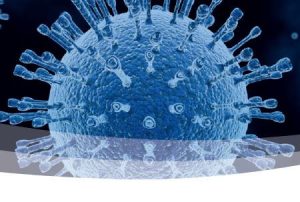Covid 19

COVID-19 The coronavirus, specifically COVID-19, is a respiratory disease. How it spreads is based on what we know about similar viruses—that it is spread from human-to-human through two main methods: airborne and surface contact.
Particle size of viruses ranges from 0.05 to less than 0.005 microns but they typically attach themselves to larger particles when airborne. These particles are generally around 1 micron in size. Viruses typically become airborne via droplet nuclei. Droplet nuclei are microscopic particles < 5 µm in size that are the leftover particles of evaporated droplets and are produced when a person coughs, sneezes, shouts, or sings. These particles can remain suspended in the air for prolonged periods of time and can be carried great distances on air currents
With contact and smear infections, the pathogens are transmitted by touch. Sick patients may also have viruses on the palms of their hands. If they shake hands with other people, the viruses are transmitted. Infection can also be indirectly transferred via objects such as door handles. Thorough hand washing is an effective way of preventing contact infections. Good hygiene practices support virus protection.
It is important to note that the increase of efficiency in air filtration will reduce the number of airborne particles thus reducing the risk of airborne transmission. However, there is a danger in just simply upgrading your filter to a MERV 13. Th goal is to upgrading the ‘system ‘efficiency, or more simply stated the goal is to improve the cleanliness of the air in your building. Just simply removing your old filter and installing a filter rated at MERV 13 (or higher) does not guarantee you will have improved ‘system’ efficiency.
Let’s look at a couple of example; Air bypass is the dirty/contaminated air that flows through gaps between filters, gaps between the filter and housing/holding frame or gaps in the housing/ductwork rather than going through the filter. Unfiltered and contaminated air can enter the occupied space. Air bypass has been documented in studies to show an efficiency loss of several MERV values. For example: if there is air bypass around a MERV 13 filter it could reduce the system efficiency to a MERV 10 or 11 and depending on the amount of bypass (size of the gap) the efficiency loss could be even greater.
When pleated filters are tested per ASHRAE 52.2, they are taped into the test duct to prevent any air bypass, so the MERV rating is calculated with zero air bypass. If you are using pleated filters with a cardboard frame, you WILL have bypass of unfiltered air unless you take extreme measures. Any of the agencies that are requesting that you upgrade to MERV 13 (or higher) advise to be sure to tightly seal the filters in the HVAC unit to prevent air bypass. If there is not an airtight seal, you cannot achieve MERV 13 system efficiency.
Click Here to Download the Covid 19 Commercial Use Brochure
Click Here to Download the Contamination Control Brochure
Click Here to Download the Covid Transmission Prevention Brochure
COVID Protection Against Viruses
Only ventilation systems that are specially designed and approved for this specific purpose offer reliable protection when physically handling viruses.
For example, these include microbiological safety cabinets approved by TÜV in accordance with EN 12469 (prescribed filter class H 14 in accordance with EN 1822).
Class H 14 HEPA filters retain at least 99.995 % of particles, bacteria and viruses with the size around 100 nm.

